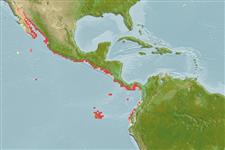Common names from other countries
>
Holocentriformes (Squirrelfishes, soldierfishes) >
Holocentridae (Squirrelfishes, soldierfishes) > Myripristinae
Etymology: Myripristis: Greek, myros, -ou = male of morey eel + Greek, pristis = saw (Ref. 45335).
More on author: Valenciennes.
Environment: milieu / climate zone / depth range / distribution range
Ecologia
marinhas associadas(os) a recifes; intervalo de profundidade 3 - 24 m (Ref. 5227). Tropical; 32°N - 1°S
Eastern Pacific: Gulf of California to Ecuador, including the Galapagos Islands. Also found in the Revillagigedo and Cocos islands (Ref. 36626).
Tamanho / Peso / Idade
Maturity: Lm ? range ? - ? cm
Max length : 18.0 cm TL macho/indeterminado; (Ref. 55763); common length : 12.0 cm TL macho/indeterminado; (Ref. 55763)
Descrição breve
Chaves de identificação | Morfologia | Morfometria
Espinhos dorsais (total) : 11; Raios dorsais moles (total) : 12 - 15; Espinhos anais: 4; Raios anais moles: 11 - 13; Vértebras: 26. Branchiostegal rays: 8-8 (Ref. 36626).
Adults hide under conspicuous rocks and small caves during the day. Form small groups on rocky and occasionally soft substrates or near the surface at night. Feed principally on crustaceans. Oviparous, with planktonic larvae (Ref. 36626). Appear occasionally in markets and marketed fresh.
Life cycle and mating behavior
Maturities | Reprodução | Spawnings | Egg(s) | Fecundities | Larvas
Oviparous (Ref. 36626). Also Ref. 240.
Schneider, W. and F. Krupp, 1995. Holocentridae. Candiles. p. 1182-1185. In W. Fischer, F. Krupp, W. Schneider, C. Sommer, K.E. Carpenter and V. Niem (eds.) Guia FAO para Identification de Especies para lo Fines de la Pesca. Pacifico Centro-Oriental. 3 Vols. FAO, Rome. (Ref. 9307)
Categoria na Lista Vermelha da IUCN (Ref. 130435)
CITES (Ref. 128078)
Not Evaluated
Ameaça para o homem
Harmless
Utilização humana
Pescarias: pouco comercial
Ferramentas
Relatórios especiais
Descarregue XML
Fontes da internet
Estimates based on models
Preferred temperature (Ref.
115969): 22.4 - 29.1, mean 26.7 (based on 225 cells).
Phylogenetic diversity index (Ref.
82804): PD
50 = 0.5000 [Uniqueness, from 0.5 = low to 2.0 = high].
Bayesian length-weight: a=0.01950 (0.01089 - 0.03490), b=3.13 (2.97 - 3.29), in cm Total Length, based on LWR estimates for this species & Genus-body shape (Ref.
93245).
Nível Trófico (Ref.
69278): 3.1 ±0.30 se; based on food items.
Resiliência (Ref.
120179): Elevada, tempo mínimo de duplicação da população menor que 15 meses (Preliminary K or Fecundity.).
Fishing Vulnerability (Ref.
59153): Low vulnerability (10 of 100).
